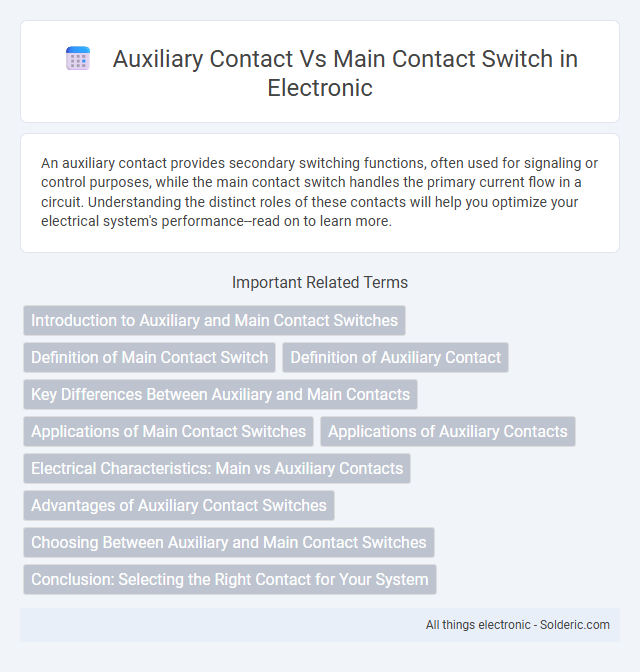An auxiliary contact provides secondary switching functions, often used for signaling or control purposes, while the main contact switch handles the primary current flow in a circuit. Understanding the distinct roles of these contacts will help you optimize your electrical system's performance--read on to learn more.
Comparison Table
| Feature | Auxiliary Contact | Main Contact |
|---|---|---|
| Function | Provides status feedback or control signaling | Handles primary power switching |
| Current Rating | Low current, typically under 10A | High current, can handle tens to hundreds of amps |
| Application | Used for control circuits and indicators | Used for load switching and power delivery |
| Contact Type | Normally Open (NO) or Normally Closed (NC) | Usually NO, designed for high power |
| Location | Attached to or integrated within main switches/contactors | Main part of the switching device |
| Role in Circuit | Signals status, interlocking, or auxiliary functions | Controls power flow to the load |
Introduction to Auxiliary and Main Contact Switches
Auxiliary contact switches serve as secondary control devices that provide feedback or signaling functions in electrical systems, while main contact switches handle the primary current flow to power equipment. Auxiliary contacts are typically low-current contacts used for control circuits, whereas main contacts carry the full load current to switch power devices on or off. Understanding the differences between your auxiliary and main contact switches is crucial for ensuring proper circuit design and operational safety.
Definition of Main Contact Switch
A main contact switch is the primary electrical connection point in a circuit, designed to carry the full operational current load and control the power flow in devices like circuit breakers or contactors. It serves as the main pathway for current, ensuring safe and reliable switching of electrical power. Auxiliary contacts, in contrast, are secondary switches that provide additional control or signaling functions without carrying the main current load.
Definition of Auxiliary Contact
An auxiliary contact is a secondary switch component that operates in conjunction with the main contact, providing additional control functions such as signaling or interlocking. It does not carry the primary load current but instead transmits auxiliary signals to control circuits or indicator systems. You can use auxiliary contacts to enhance the functionality and safety of electrical switching devices.
Key Differences Between Auxiliary and Main Contacts
Auxiliary contacts are secondary switches used to signal the status of the main contact or control additional circuits without interrupting the main power, whereas main contacts handle the primary current flow and power switching in a device. The main contact is designed for high current capacity and directly controls load circuits, while auxiliary contacts operate with lower current ratings and are primarily reserved for control and signaling purposes. Key differences include their roles in circuit design, current capacity, and functionality--main contacts focus on power transmission, auxiliary contacts enhance system control and feedback.
Applications of Main Contact Switches
Main contact switches are primarily used in power circuits to control large electrical loads such as motors, lighting systems, and industrial machinery. These switches handle high current and voltage levels, making them essential for safely managing power distribution in commercial and industrial settings. Your choice of a main contact switch ensures reliable operation and protection for critical electrical equipment.
Applications of Auxiliary Contacts
Auxiliary contacts are widely used in electrical control systems to provide signaling and interlocking functions, enabling safe and efficient operation of motors, relays, and circuit breakers. They allow remote indication of the main contact position, facilitate automation by triggering secondary circuits, and enhance safety by integrating with protection devices. Common applications include status feedback for control panels, sequencing operations in motor starters, and implementing safety interlocks in industrial machinery.
Electrical Characteristics: Main vs Auxiliary Contacts
Main contacts in switches handle high current loads with ratings typically ranging from 10A to 100A, ensuring robust power transmission and circuit control. Auxiliary contacts operate at much lower current levels, often below 5A, designed primarily for signaling and control circuits rather than direct power switching. Your choice should consider the electrical characteristics to match load requirements, ensuring safety and functionality in your control system design.
Advantages of Auxiliary Contact Switches
Auxiliary contact switches offer precise control and monitoring capabilities by providing additional signaling options without interrupting the main circuit, enhancing safety and operational efficiency. They enable remote indication and interlocking functions, reducing downtime and improving maintenance processes. Your electrical system benefits from increased reliability and easier troubleshooting through the integration of auxiliary contacts alongside main contact switches.
Choosing Between Auxiliary and Main Contact Switches
Choosing between auxiliary and main contact switches depends on the electrical load and control requirements; main contact switches handle high power circuits and are designed for making and breaking the primary current flow, while auxiliary contact switches are intended for signaling and control functions, providing feedback without carrying heavy loads. Reliability and application-specific needs dictate the choice, with main contacts suited for switching motors or heavy machinery, and auxiliary contacts preferred for control circuits in programmable logic controllers (PLCs) or alarm systems. Proper selection ensures safety, system efficiency, and prolongs the lifespan of the electrical components.
Conclusion: Selecting the Right Contact for Your System
Choosing the right contact switch depends on the specific application requirements; main contacts handle higher current loads and provide the primary switching function, while auxiliary contacts serve control circuits with lower current ratings and signal status. Evaluating factors like load capacity, electrical endurance, and intended control signals ensures optimal performance and system safety. Proper selection enhances reliability by matching contact types to their operational roles within electrical systems.
auxiliary contact vs main contact switch Infographic

 solderic.com
solderic.com